Dear Barbara,
In 1944, an Englishman parachuted into Crete. By the time of his arrival, he hadn’t published a book yet. Despite having already lived an exciting life, the misty night he landed in Crete, he wasn’t technically a writer. He landed as a Special Operations Executive Officer (SOE) with a single military goal: to abduct Friedrich-Wilhelm Müller.
Müller was a war criminal and the German 22nd Air Landing Division commander during World War II. However, by the time the entire abduction team was gathered on the island, Müller had been replaced by Heinrich Kreipe. Despite the change, the plan remained: abducting a German general from Nazi-occupied Crete was meant to be an act of heroism.
It was not an easy plan, yet it had to be carried out in detail and executed perfectly. Thousands of German soldiers were stationed on the island and burned significant parts of it. Death was just around the corner. And, at some point, the man who parachuted into Crete had to impersonate Heinrich Kreipe to make the plan work.
The landscape in Crete
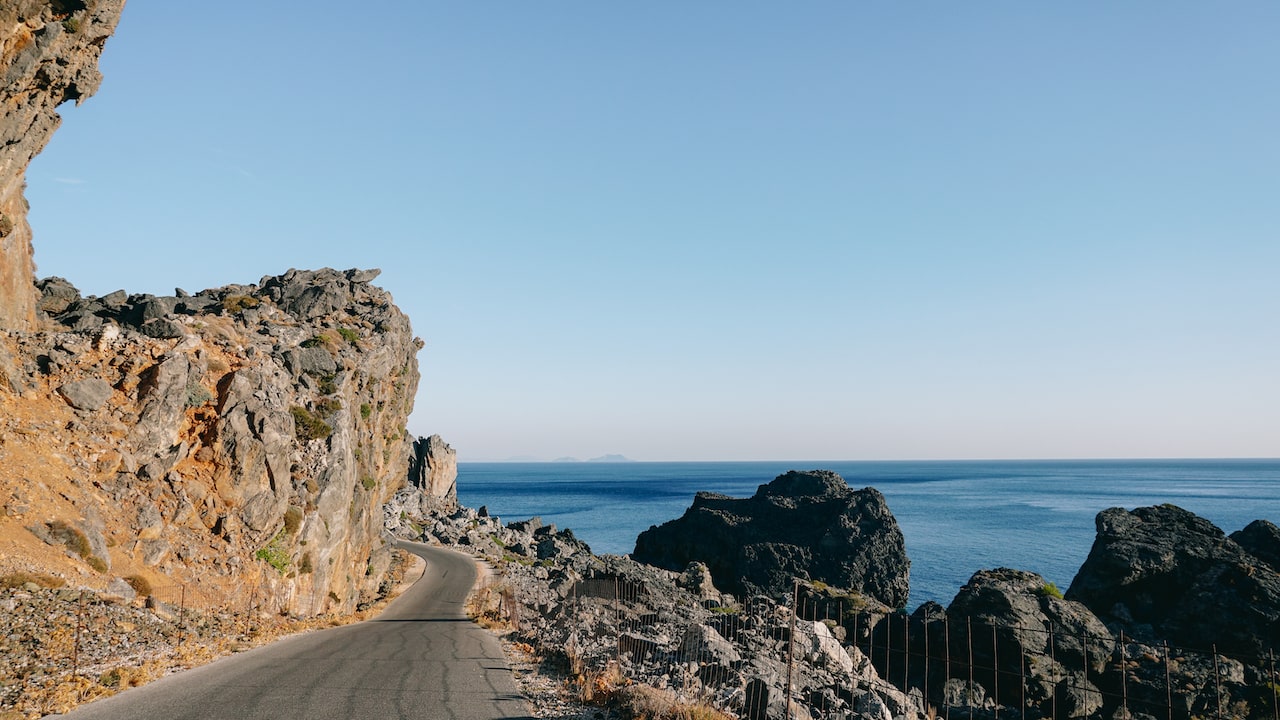
Sheepbells echo in the mountains. It’s not just a distinct sound; it’s the melody of the Cretan mountains, a soundtrack that rolls along the slopes and sits atop the waves. The northern winds carry that music through trees and country roads, and travelers turn their heads searching for the sheep. Yet, those delicate animals remain usually invisible. It’s a natural camouflage -and the sole way to stay unnoticed in the landscape of Crete.
For an island this size, the roads feel narrow. I never feel comfortable in cars, and narrow streets keep stressing me. Let alone the dirt roads. We roll through Crete’s glorious territory on a rented car. Downhill ones follow steep roads, and this garland of ups and downs becomes an existential quest.
Quite often, there’s not enough space for two cars. Not that the network on this side of Crete is that busy. But the rare moment you encounter the vehicle of a fellow traveler or a local going to the olive grove, you need to slow down. You must act instantly and do the maths: the space, the time, and the steering wheel require accurate handling. Impatience is never rewarded in Crete.
Short breaths or no breathing at all. The cliffs are dramatic, and death is just around the corner, just like back in 1944. The most stunning and remote beaches of Crete, the ones on the way from Plakias to Frangokastello, are approximately half an hour away. Their names are mysterious and a bit obscure.
One of them, though, has the name of a fruit.
Abducting a general
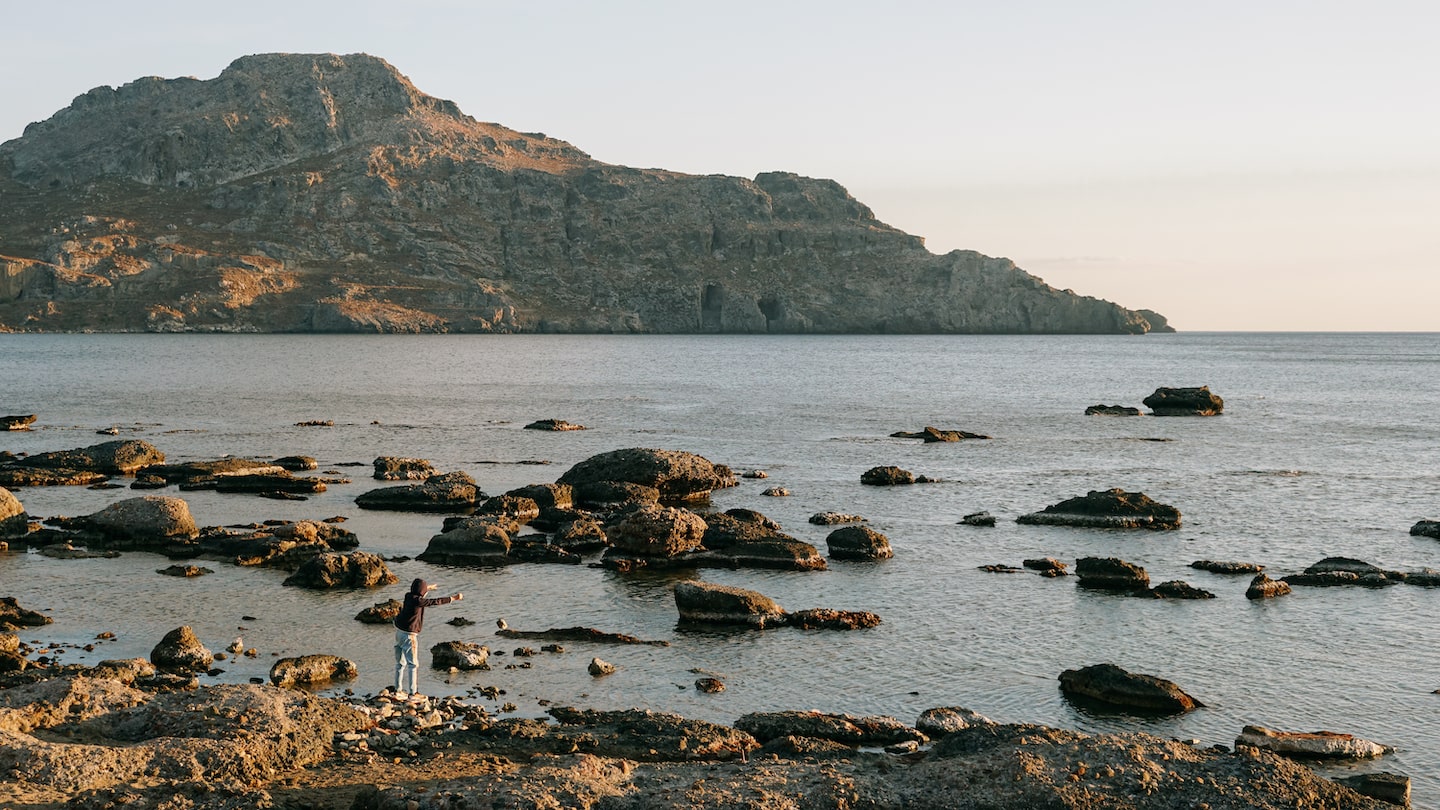
While waiting for his team, the Englishman joined the local resistance forces. However, the initial plan to abduct Müller was altered. On March 1, 1944, Müller was replaced by Heinrich Kreipe. Although there were thoughts of canceling the entire operation, the Englishman insisted. Kreipe might not have been as notorious as Müller, but abducting a German general in Nazi-occupied Crete would be a symbolic act. Moreover, an act of heroism organized by SOE and the local resistance would lift the island’s morale.
The narrow streets of Crete were heavily guarded. The Englishman and his companion waited weeks for a signal that Kreipe was about to leave his house. They were ready and knew they had to risk their lives.
The signal finally came on the night of April 26, 1944. The two Englishmen changed their clothes and wore German uniforms. When a local resistance member flashed his torch thrice, they knew Kreipe’s car was approaching.
The two men stopped the car. German soldiers had the right to routine checks even on the vehicles of generals. Kreipe’s driver stopped, and the dressed-up officers asked for their identity papers. The Englishman who parachuted into Crete opened Kreipe’s door and pressed his chest with a gun. Soon, other resistance members appeared out of Crete’s wilderness, and a short fight followed. Kreipe’s driver was injured.
The two Englishmen impersonated Kreipe, and his driver—the one who parachuted into Crete was supposed to be the general. The car didn’t go through just one or two checkpoints. On the road from Heraklion to Rethymno, they passed through 22 German checkpoints and went through them easily. The checkpoint guards knew how impatient Kreipe was with these random checks.
During the ride with the abducted general, the car’s driver was the British William Stanley Moss, the leader of the abduction team. Moss later wrote books and traveled the world. The man who parachuted into Crete and impersonated Heinrich Kreipe was Patrick Leigh Fermor, who’d become one of the greatest travel writers of all time.
A writer in Crete
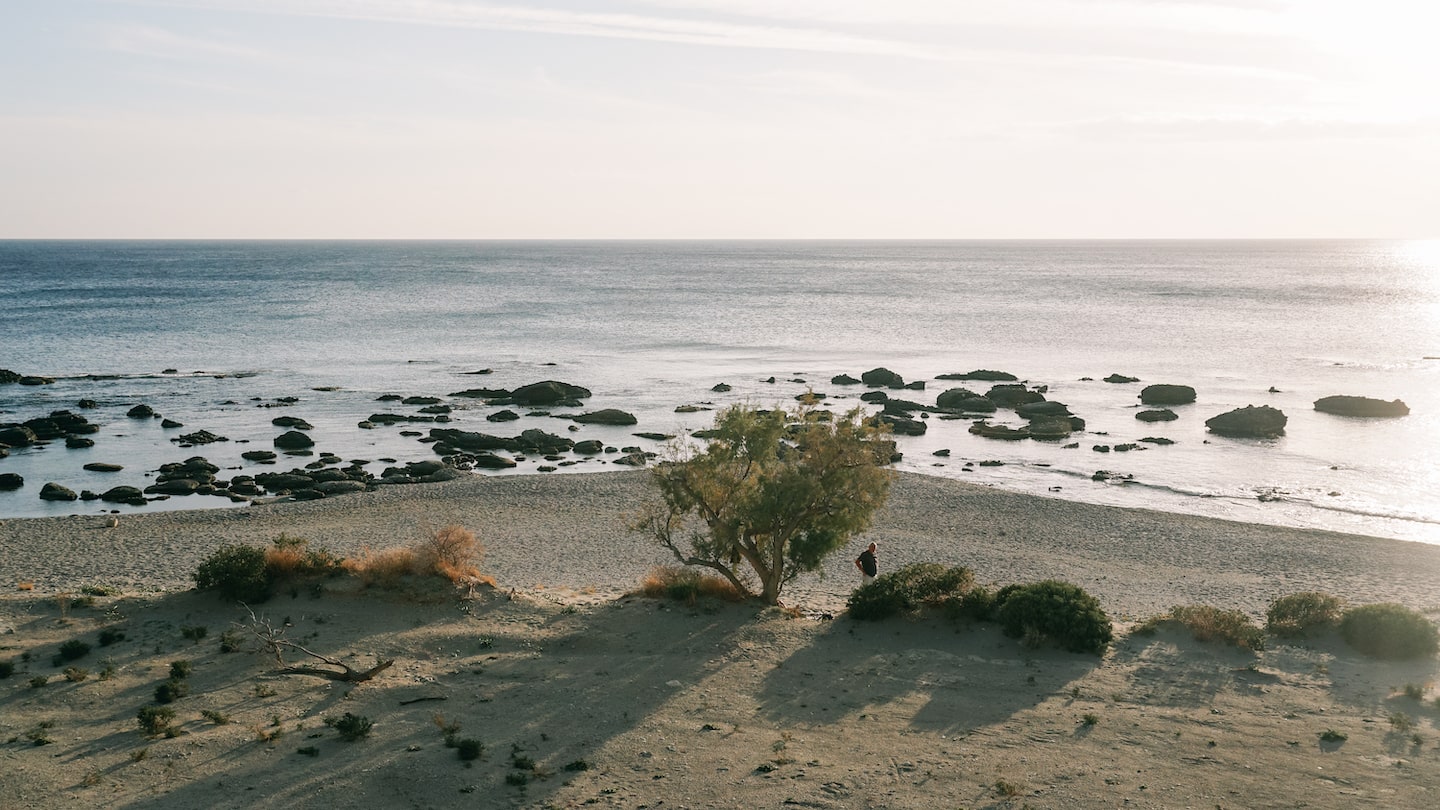
The first time I visited Crete, I was technically a writer. It was back in 2017, and I had already published three books. During that first journey in Crete, I was working on my fourth book, which was published three years later.
I clearly remember those sunny autumn days in Crete. It was the first time I had traveled somewhere with Barbara, but I hadn’t started writing those letters to her. Creating the blog wasn’t in my mind, and in this old journey, I had to deal with grief. I remember driving around the car and thinking of the future: what I should write, how I could make a living, what it means to have people in my life, and how to take care of them.
Exactly like in the current journey, I wanted to swim, eat fish, and write. The rocky landscape of Crete, which became tender only by the sea, resembled an internal landscape. How can somebody soften their inner sharp-edged stones and create something fluid out of them?
I kept having a pen and a paper with me. Back then, I’d wake up in the middle of the night to write a thought that in the morning didn’t sound convincing anymore. I’d save the best hours of the day for writing and then try to be around the people of my life.
The narrow roads of Crete, where impatience is never rewarded, didn’t just offer a journey; they created one. Triopetra, Sfakia, Frangokastello, Matala, Komos. A Greek has the privilege of knowing about these places even without visiting them, but foreign travelers are blessed to discover them without prior knowledge. They get a crispy, unadulterated impression that feels like seeing in front of their eyes a place that they once dreamt of in their sleep—a moment as virgin as the Cretan olive oil.
I was a writer when I visited Crete back then. But I don’t know if I’m still after the last journey to Crete.
Off to the sea
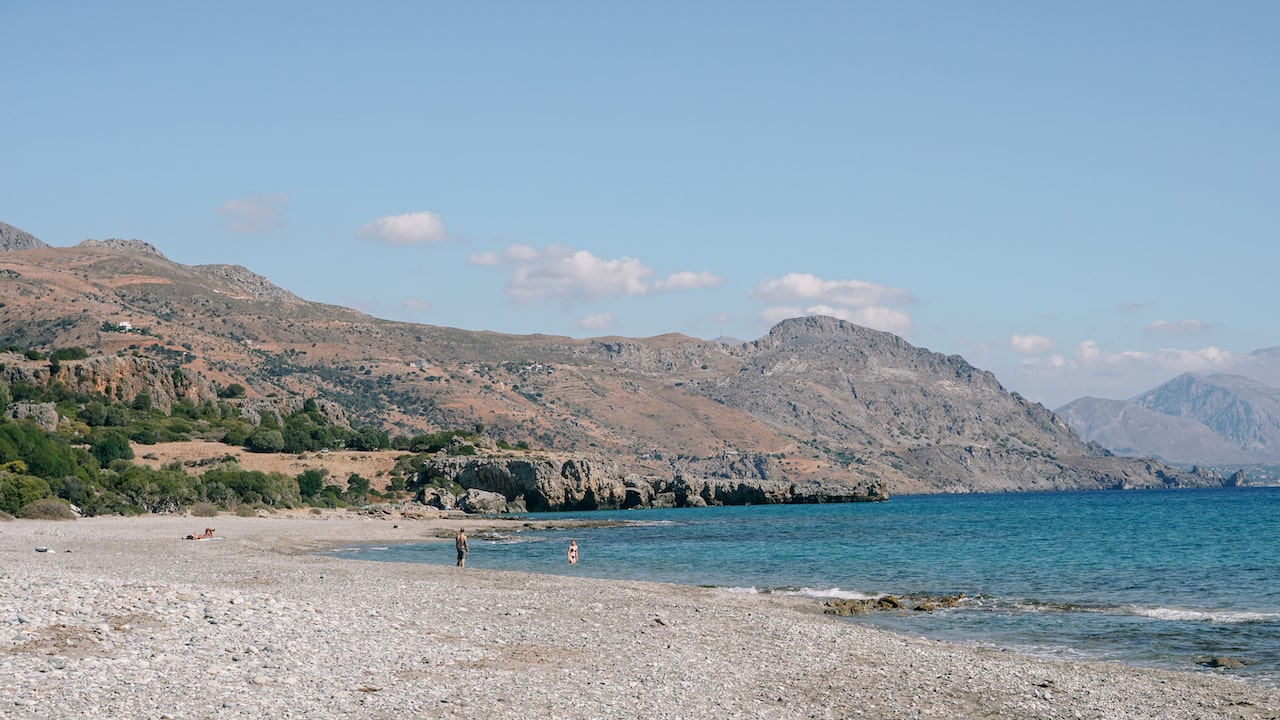
The general was abducted—but now what? The plan was to take him out of Crete and interrogate him. This wasn’t an easy task, and abducting a general on occupied soil meant high risks and danger. One wrong step and death was around the corner. They had to wait as much as needed; impatience was never rewarded in Crete.
The local resistance, including Fermor and Moss, had to remain off the radar. To ensure personal and operational security, they built a silent network consisting of torches, secret passages, cars, messengers, and hideouts. In addition, they had to move continuously to avoid raising suspicions and being arrested.
The German forces on the island were instantly informed about the incident. At the beginning of May, the resistance tried to organize an escape from a beach south of Rethymno. Implementing the plan took more than ten days, as everything had to be planned perfectly.
Everything was ready on the night of May 14, 1944. A messenger had told them that a small boat would pick them up from a beach close to Rodakino Beach. Rodakino stands for peach in Greek, and one might imagine a very fertile landscape. The team that would flee out of Crete consisted of Kreipe, two German prisoners of war, a Soviet prisoner, and members of the resistance, among them Fermor and Moss.
The boat awaited them at Peristere Beach, which is part of Rodakino. At 10 pm, the ship started its trip on the Libyan Sea and, some hours later, reached Mersa Matruh in Egypt. Kreipe was interrogated and then transferred to Canada.
After the war, Patrick Leigh Fermor published his first book and became one of the greatest travel writers of all time.
The tavern in front of the plaque
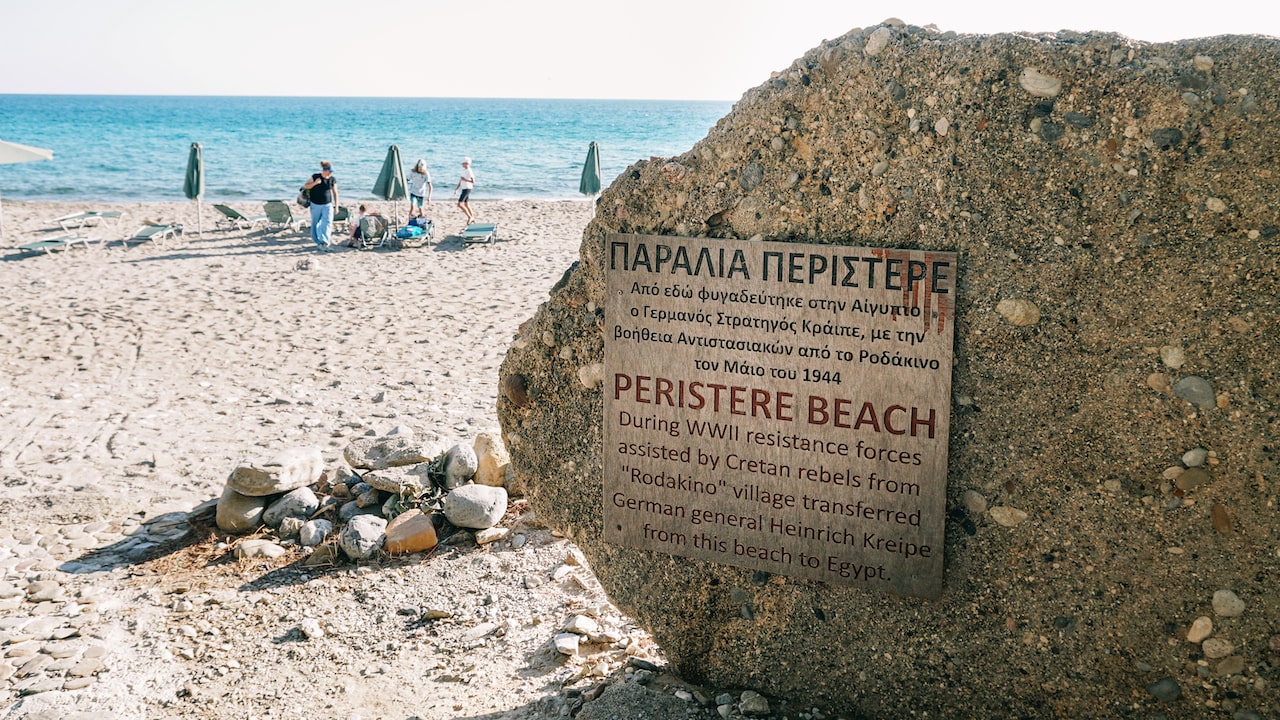
The last part of the road after Polirizos Beach stresses me. There’s no asphalt, just worn-out cement with potholes. It’s steep and then downhill, and the road is insufficient for even one car. But at least, at the final few meters, the road softens, and the sea appears in the distance, between the trees, like a shiny blue peach.
At Peristere Beach, a tall tree and a few cars are parked in its shadow. An old orange camper with the word “Kantina” rests after serving thousands of vacationers. The sun is intense even at the end of October. We swim in the sea, and afterward, we head to the Canteen of Manolis. It’s the season’s end. We sit at the table on the edge of this improvised tavern.
The sea, the rocks, and a strong northern wind. The food is delicious, and the raki flows. Straight in front of our table, there’s a plaque commemorating the resistance group’s flee to Egypt. Fermor’s name is not on the plaque; no names are mentioned. It’s a frugal plaque attached to a rock and the open sea behind it.
A moment later, I hear invisible sheep bells. Being a writer in Crete doesn’t seem to mean anything about the written word. The island demolishes certainties and offers perspectives. It’s the sand, the plaque of an event, and a canteen on the beach’s edge.
Peach days under the sun. We are one wave out of Africa and a steep, narrow road back to daily life. And we both know how this ends.
Love,
George
More about Crete: Crete photography and guide, How to get from Athens to Crete
Pin it for later
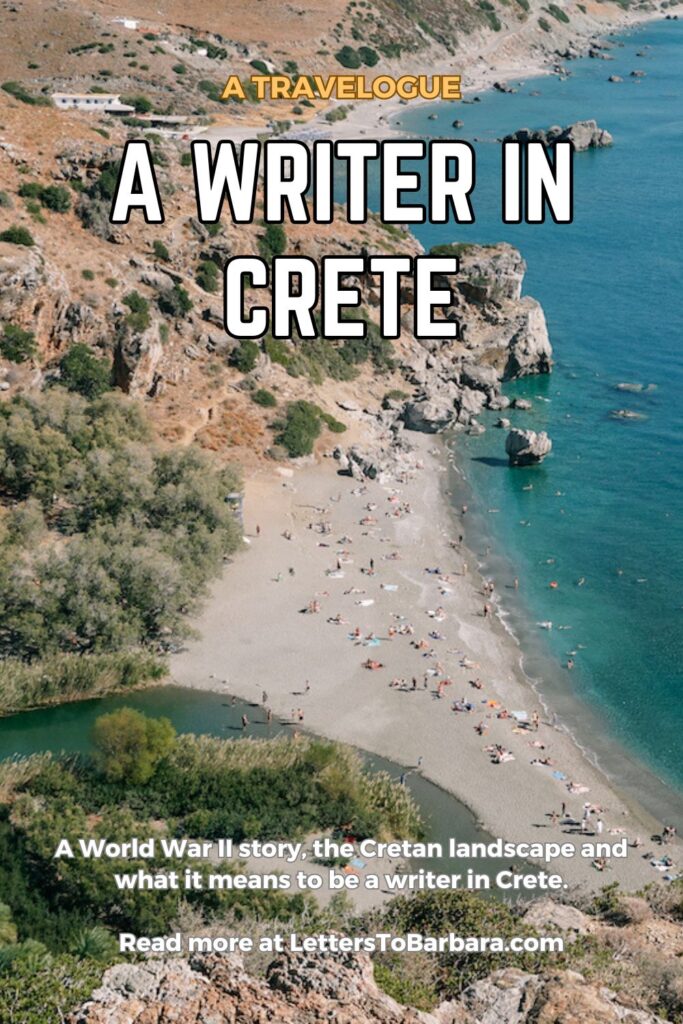
Sharing is caring. Share the travelogue A writer in Crete with your friends.
Last Updated on November 23, 2024 by George Pavlopoulos


I knew British author Roald Dahl was involved in World War II but never Patrick Leigh Fermor. I’m a bit smarter now. Thanks George. Did a search to see if a movie has been made about Patrick Leigh Fermor in the war. A book popped up: Ill Met by Moonlight: The Abduction of General Kreipe. It is a non-fiction partly-autobiographical book written by W. Stanley Moss, a British soldier, writer and traveller. Moss and Patrick Leigh Fermor were both involved in the kidnapping of Heinrich Kreipe. The story was made into a 1957 film with the same title, Ill Met by Moonlight. I’ll have to watch it.
Hey John!
I didn’t know about the movie -I must watch it too! I heard about the story a couple of years ago, after my first visit to Crete. I always thought it would be nice to see Peristere Beach and imagine how it might have looked up close during that night of WW II. The landscape is raw, and it’s still an isolated beach.
Thanks for sharing the movie info!
George